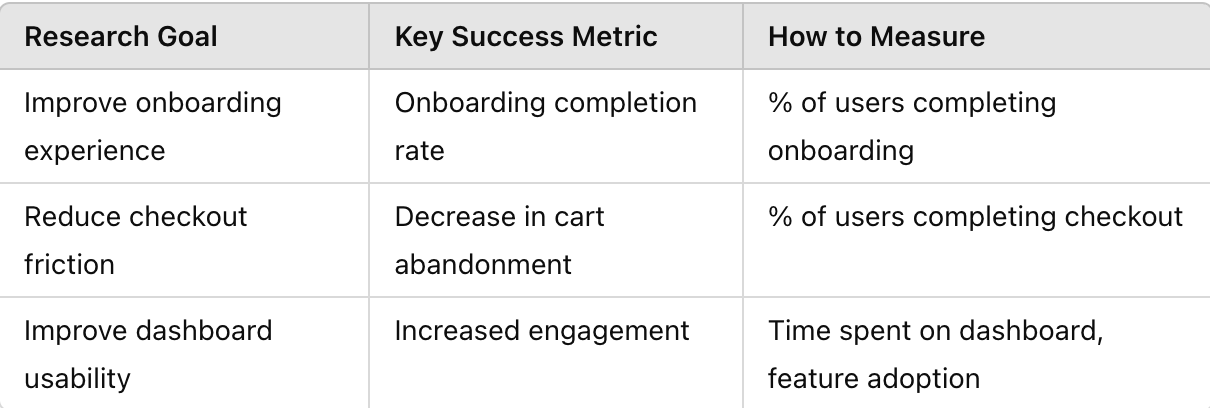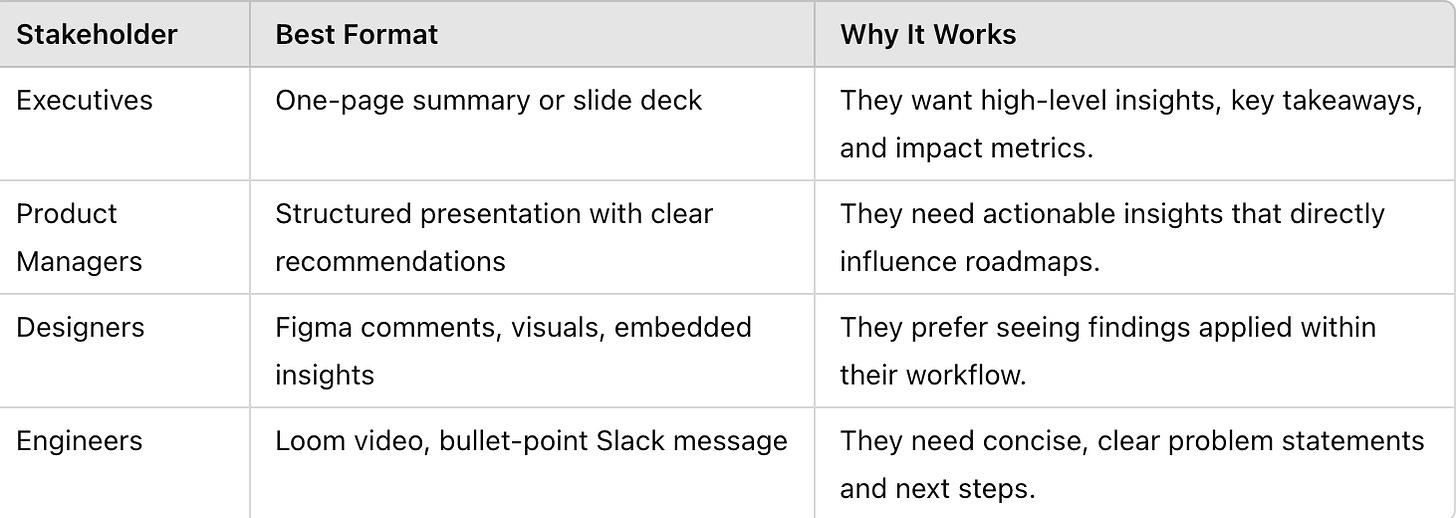How to Track the Impact of Your Research
A step-by-step guide to making research visible, measurable, and essential
👋🏻 Hi, this is Nikki with a subscriber-only article from the User Research Strategist. I share content that helps you move toward a more strategic role as a researcher, measuring your ROI, and delivering impactful insights that move business decisions.
If you want to see everything I post, subscribe below!
User researchers love uncovering insights, but let’s be honest, tracking the impact of our work? That’s a different beast. If you’ve ever felt like your research disappears into a black hole after presenting it, you’re not alone. But if you want a seat at the strategic table, you need to show your value in ways that are undeniable.
This isn’t about vanity metrics or feel-good storytelling. It’s about hard data, real influence, and making sure your work leads to tangible product decisions. Here’s how to track impact like a pro, using a structured framework that aligns with your UXR Impact Tracker.
Stop piecing it together. Start leading the work.
The Everything UXR Bundle is for researchers who are tired of duct-taping free templates and second-guessing what good looks like.
You get my complete set of toolkits, templates, and strategy guides. used by teams across Google, Spotify, , to run credible research, influence decisions, and actually grow in your role.
It’s built to save you time, raise your game, and make you the person people turn to—not around.
→ Save 140+ hours a year with ready-to-use templates and frameworks
→ Boost productivity by 40% with tools that cut admin and sharpen your focus
→ Increase research adoption by 50% through clearer, faster, more strategic delivery
Step 1: Set Up Your Impact Tracker from the Start
Most user researchers make the mistake of thinking about impact tracking after the research is complete, by then, it’s too late. The key to ensuring your work drives real change is planning for impact before you even start.
If you don’t define success from the beginning, you’ll have nothing concrete to measure later and your research could be dismissed as “interesting but not actionable.” Let’s fix that.
Define What Success Looks Like
Before launching into research, pause and answer these critical questions:
What is the problem this research is solving? (Be specific, don’t just say “improve usability” or “increase engagement.”)
Who are the key stakeholders, and what decisions will they make based on this research?
What specific metric, KPI, or business outcome will this research impact?
How will we measure whether the research was successful in 3-6 months?
Without clear answers, your research may be valuable in theory but won’t drive real product changes.
Example: Good vs. Bad Goal-Setting
Bad Research Goal: “Improve the onboarding experience.” (Too vague!)
Good Research Goal: “Identify usability barriers in onboarding that prevent users from completing the setup process. Success will be measured by an increase in onboarding completion from 60% to 75% within 3 months of implementation.” (Clear and measurable!)
Log Your Research in an Impact Tracker
Once you’ve defined the goal, immediately document it in your UXR Impact Tracker. This ensures the research is tied to a tangible outcome from the start.
Set up a new entry in your tracker with these fields:
Project name: Ensures clarity about what the research is for.
Impact statement: Defines what success looks like in measurable terms.
Research type: Specifies the type of study (usability test, survey, etc.).
Stakeholders: Identifies who will use this research to make decisions.
ROI type: Connects research to business impact (retention, cost savings).
Example entry:
Align with Stakeholders
To ensure research is used, you must get stakeholder buy-in before starting. This means having direct conversations with the people who will act on your findings.
Steps to take:
Schedule a 15-minute alignment meeting with key stakeholders (PMs, designers, leadership, engineers). Ask them directly:
“What decisions do you need to make, and how will this research inform them?”
“What’s the biggest risk if we don’t solve this problem?”
“What kind of insights will be most useful for your team?”
Document their responses in the tracker under Stakeholders & Decision Needs.
Example:
PM: “We need to know why 40% of users abandon onboarding after step 3. If we don’t fix this, we risk losing potential customers.”
Designer: “We need usability feedback on the new dashboard layout before launching it.”
If stakeholders don’t feel personally invested in the research, they won’t use the results.
End every meeting with: “What would make this research a success for you?” Their answer will help you tailor insights to drive action.
Define What Type of Impact You’re Measuring
Not all research influences product changes immediately. Some research influences strategy while other studies drive immediate fixes.
The 3 Main Types of Research Impact:
Direct Product Impact: Research findings result in product changes, UI updates, or feature adjustments.
Example: “Our study on checkout friction led to a redesigned payment flow, decreasing drop-off by 12%.”
Strategic Influence: Research shifts company priorities, informs a roadmap, or changes a long-term strategy.
Example: “Our research showed that users prioritize speed over new features, leading leadership to invest in performance improvements.”
Operational/Process Impact: Research improves internal workflows, saves time, or enhances research efficiency.
Example: “We streamlined participant recruitment, reducing turnaround time from 10 days to 4 days.”
Log the expected impact type in your tracker. This will help when measuring long-term results.
Example tracker entry:
Establish How You Will Measure Impact
Once research is complete, how will you know if it worked?
Every research project should have at least one measurable impact metric that is reviewed at 1 month, 3 months, and 6 months.
Possible metrics to track:
If you’re researching a pricing page redesign, track conversion rates before and after implementation.
If you’re testing a new signup flow, measure if more users complete registration after the update.
Set a reminder to check these metrics at 1, 3, and 6 months. If impact isn’t visible, follow up with stakeholders to investigate why.
Next steps
By now, you should have:
Defined what success looks like before starting research
Logged the project in an Impact Tracker
Aligned with stakeholders on expected decisions and impact
Identified the type of impact (product, strategy, or process)
Defined how you will measure success and set check-in reminders
Go document your next research study in an Impact Tracker and align with a stakeholder.
Step 2: Ensuring Research Gets Seen and Used
You’ve done the research. You’ve gathered valuable insights. Now, the real challenge begins: making sure people actually use it.
One of the biggest reasons research fails to drive impact is because stakeholders don’t engage with it or don’t know how to act on it.
This step ensures your findings are not just read but discussed, referenced, and used in decision-making.
Choose the Right Format for Sharing Findings
Different stakeholders consume information in different ways. If you want your research to be actionable, present it in a format they will actually engage with.
Match the format to the audience
Steps to take:
Before creating a report, ask stakeholders:
“What’s the most useful way for you to consume these insights?”
“Would a summary, a deep dive, or a quick walkthrough be best?”
Structure insights in a way that answers their key questions:
What’s the main problem?
Why does it matter?
What should we do about it?
Use clear, concise, and scannable formats:
Avoid long paragraphs.
Use bullet points and data highlights.
If possible, create an “Actionable Insights” section at the top.
Example:
Bad:
“We conducted a usability test with 10 participants to understand how they interact with the onboarding flow. Several issues were identified, including confusion around step two, lack of guidance, and unclear terminology.”
Good:
“Users drop off at step two of onboarding due to confusion. 70% of participants didn’t understand the next action. To fix this, add a progress indicator and clarify step two’s instructions. If addressed, this could increase onboarding completion by 15%.”
Present Findings in a Discussion, Not Just a Document
If you only send a research report via email or Slack, there’s a good chance it will be skimmed or ignored.
Instead, schedule a research readout or discussion session where you can walk stakeholders through the insights and ensure they understand them.
How to run a research readout session:
Keep it short (15-30 minutes).
Stakeholders have limited time. Focus on the most critical insights.
Start with the conclusion.
Lead with the main takeaway, not the background.
Make it interactive.
Ask stakeholders:
“Does this align with what you expected?”
“What questions does this raise for you?”
“How can we apply this immediately?”
Have clear next steps at the end.
Assign owners to actions.
Get verbal commitments from PMs or designers on what they’ll do next.
Example agenda for a 20-minute readout:
A discussion ensures engagement. A report alone can be ignored, but a conversation forces action.
Track Stakeholder Engagement and Reactions
Once research has been shared, it’s important to track who engaged with it and how they responded.
If no one asks follow-up questions or discusses the findings, that’s a warning sign that the research is not being absorbed.
What to track in your impact tracker:
Example stakeholder engagement log
If you share findings and receive silence, take action:
Send a follow-up message:
“I wanted to check in, do you see any immediate next steps based on these findings?”
Tie it back to roadmap goals:
“Since this aligns with the Q2 roadmap, I want to make sure we discuss implementation.”
Set up a quick 10-minute sync:
“Would a quick discussion help clarify anything? Happy to jump on a call.”
Why this matters: Research that isn’t engaged with won’t be acted on. Ensuring discussion and action is critical to making research impactful.
Assign Ownership and Next Steps
Even if stakeholders love the insights, research won’t drive impact unless someone is responsible for acting on it.
Steps to Take:
At the end of your readout, assign clear action items:
“PM to update the roadmap to include X change.”
“Designer to update UI elements based on findings.”
“Engineer to investigate feasibility of the recommendation.”
Log these next steps in the Impact Tracker.
Example impact tracker entry for next steps
Follow up within 2-4 weeks.
f no action has been taken, check in with assigned owners.
Without clear ownership, research can sit idle. Assigning responsibility ensures it turns into real changes.
Next steps
By now, you should have:
Shared findings in the right format for your audience
Presented research in a discussion, not just a document
Tracked who engaged, what was said, and what actions were taken
Assigned clear owners for next steps
Go back to your last research project and check:
Was it shared in the most effective way?
Did stakeholders engage with it?
Are there clear next steps documented?
If not, adjust how you share research going forward.
Step 3: Measuring Impact Over Time
You’ve shared the research. You’ve got stakeholder engagement. But how do you prove the research actually made a difference?
This step is about tracking what happens after research is delivered, following up to ensure action is taken, and measuring long-term impact.
Most research impact doesn’t happen overnight. Stakeholders may agree with your findings, but implementation takes time. Without a structured follow-up process, research can get lost in the shuffle.
This step ensures that your insights turn into real changes and that you can quantify their impact.











